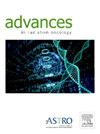Artificial Intelligence-Assisted Compressed Sensing Technique Accelerates Magnetic Resonance Imaging Simulation for Head and Neck Cancer Radiation Therapy
IF 2.7
Q3 ONCOLOGY
引用次数: 0
Abstract
Purpose
To explore the potential of artificial intelligence-assisted compressed sensing (ACS) technique, when compared with that of conventional parallel imaging (PI) technique, in magnetic resonance imaging (MRI) simulation for head and neck cancer radiation therapy.
Methods and Materials
Fifty-two patients with pathologically confirmed head and neck cancer underwent MRI simulation using a 3.0-T MRI simulation system. For each patient, axial T1-weighted gradient spin echo, T2-weighted fast spin echo sequence, and postcontrast and postcontrast fat-suppressed T1-weighted gradient spin echo sequence were obtained by ACS and PI. Acquisition time, signal-to-noise ratio, contrast-to-noise ratio, and image quality of both sets of MRI simulation images were compared. Image quality analysis was scored with lesion detection, margin sharpness of lesions, artifacts, and overall image quality using the 5-point Likert scale. Moreover, tumor target volume acquired from fusion images of simulation computed tomography with simulation MRI by ACS and from fusion images by PI were compared. Dice similarity coefficient of gross tumor target between fusion images by ACS and those by PI were also measured.
Results
Acquisition time of MRI simulation by ACS was significantly shorter than that by PI, whether for the time of individual sequence or the total acquisition time (P < .05 for all). The mean total acquisition time by PI (694.78 ± 16.85 seconds) was significantly less after using ACS (378.50 ± 10.05 seconds), with a mean reduction ratio 45.52%. Signal-to-noise ratio, contrast-to-noise ratio values and qualitative image scores (lesion detection, margin sharpness, artifacts, and overall image quality) were almost comparable between ACS and PI. Mean tumor target volume of both primary tumors and metastatic lymph nodes acquired from fusion images by ACS were also comparable to those from fusion images by PI (P > .05 for all). Mean Dice similarity coefficient values for primary tumors and metastatic lymph nodes were both close to 1.
Conclusions
Compared to PI, ACS can significantly accelerate MRI simulation for head and neck cancer radiation therapy without compromising image quality and degrading the guidance role of tumor target delineation.
人工智能辅助压缩感知技术加速头颈部肿瘤放射治疗磁共振成像仿真
目的探讨人工智能辅助压缩感知(ACS)技术与传统并行成像(PI)技术在头颈部肿瘤放射治疗磁共振成像(MRI)模拟中的应用潜力。方法与材料采用3.0 t MRI模拟系统对52例经病理证实的头颈癌患者进行MRI模拟。ACS和PI分别获取每位患者轴向t1加权梯度自旋回波、t2加权快速自旋回波序列、对比后和对比后脂肪抑制t1加权梯度自旋回波序列。比较两组MRI模拟图像的采集时间、信噪比、对比噪比和图像质量。图像质量分析采用5点李克特量表对病变检测、病变边缘清晰度、伪影和整体图像质量进行评分。此外,还比较了ACS和PI融合图像获得的模拟计算机断层扫描与模拟MRI融合图像获得的肿瘤靶体积。并测量了ACS融合图像与PI融合图像的大体肿瘤目标的骰子相似系数。结果无论是单个序列的采集时间还是总采集时间,ACS对MRI模拟的采集时间均明显短于PI (P <;0.05)。使用ACS后,PI的平均总捕获时间(694.78±16.85秒)明显缩短(378.50±10.05秒),平均还原率为45.52%。信噪比、噪比值和定性图像评分(病变检测、边缘清晰度、伪影和整体图像质量)在ACS和PI之间几乎相当。从ACS融合图像中获得的原发肿瘤和转移性淋巴结的平均肿瘤靶体积也与PI融合图像相当(P >;0.05)。原发肿瘤和转移性淋巴结的平均Dice相似系数值均接近1。结论与PI相比,ACS在不影响图像质量和降低肿瘤靶点描绘的指导作用的情况下,可显著加快头颈部肿瘤放射治疗的MRI模拟。
本文章由计算机程序翻译,如有差异,请以英文原文为准。
求助全文
约1分钟内获得全文
求助全文
来源期刊

Advances in Radiation Oncology
Medicine-Radiology, Nuclear Medicine and Imaging
CiteScore
4.60
自引率
4.30%
发文量
208
审稿时长
98 days
期刊介绍:
The purpose of Advances is to provide information for clinicians who use radiation therapy by publishing: Clinical trial reports and reanalyses. Basic science original reports. Manuscripts examining health services research, comparative and cost effectiveness research, and systematic reviews. Case reports documenting unusual problems and solutions. High quality multi and single institutional series, as well as other novel retrospective hypothesis generating series. Timely critical reviews on important topics in radiation oncology, such as side effects. Articles reporting the natural history of disease and patterns of failure, particularly as they relate to treatment volume delineation. Articles on safety and quality in radiation therapy. Essays on clinical experience. Articles on practice transformation in radiation oncology, in particular: Aspects of health policy that may impact the future practice of radiation oncology. How information technology, such as data analytics and systems innovations, will change radiation oncology practice. Articles on imaging as they relate to radiation therapy treatment.
 求助内容:
求助内容: 应助结果提醒方式:
应助结果提醒方式:


